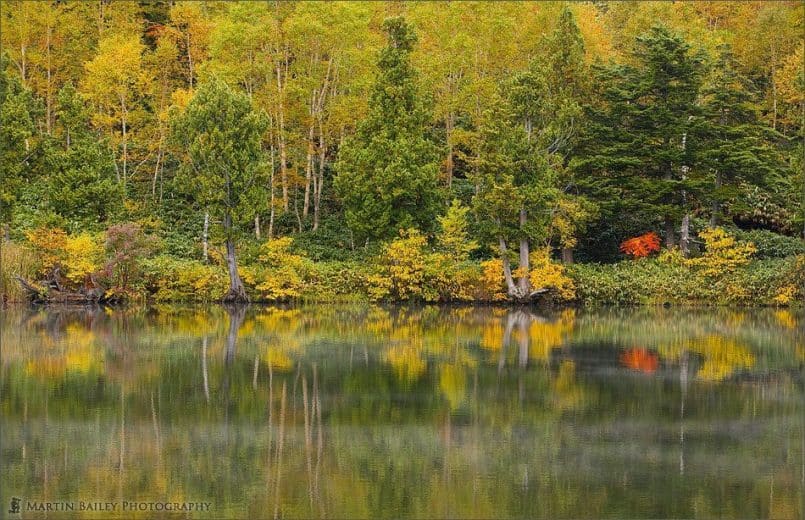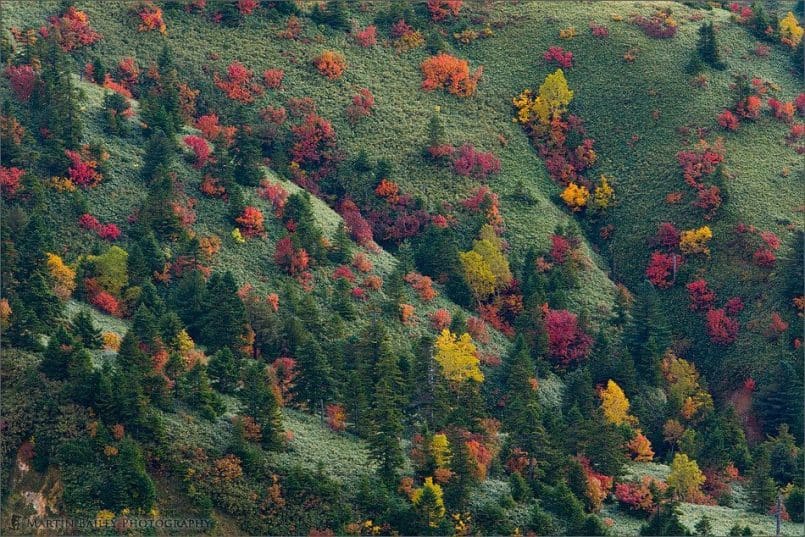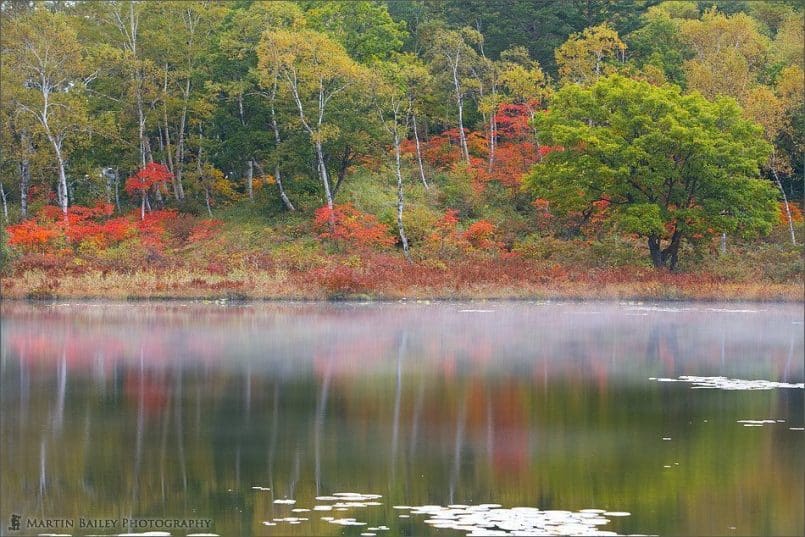Part way through last week’s episode I realized that it was going to be far too long for one episode and then suddenly decided to split it into two. Today we’re going to look through the rest of my shots from my recent trip to Shigakougen, a Highland Plateau in the Nagano Prefecture, north-west of Tokyo. I visited this location at this time last year too, which I spoke about in Episodes 58 and 59. This year was another adventure, with me again deciding to drive at night to get to a popular vantage point early enough to park my car. This time we actually booked the following two nights in a nice little hotel too, and made a bit of a break out of it, so let’s sit down talk about my experiences over the three days.
I’m quite pleased with the next shot, number 1587. I pulled up at this pond, which is Kidoike, shortly before noon, but it was overcast, so the light was being kind to me. There were patched of mist rolling across the surface of the pond from time to time, and I decide to work the scene a little to see what I could get. This first image appeals to me because the mist on the water is kind of patchy, just slightly disrupting the almost mirror like reflection of the trees in the surface of the water. With the altitude being maybe a couple of hundred meters higher than Ichinuma that we looked at earlier, the yellow leaves were also coming on a little more here. To break that up though, we have one solitary orangey-red Urushi bush, which along with its reflection really tops the shot off with a nice accent. I shot this with the 70-200mm F2.8 lens at 110mm, just isolating a small portion of the bank on the opposite side of the pond. It was shot at F8 for 1/30th of a second with ISO 100. At this distance F8 is enough to get everything I want sharp, and I find that with this lens, as with most, it’s really the sharpest aperture setting, though the others are also very sharp. I used a tripod for all of the shots we’re looking at by the way.
The next image, number 1590, was also shot with the 70-200mm at 73mm, but this is actually a stitch of around 7 images shot vertically. I rotated the lens in its tripod ring, as usual. Note that I rarely turn the camera on its side with lenses that have a tripod ring. It keeps everything so much better balanced to just rotate the lens in the ring. I made sure my tripod was level too. I used the Gitzo for this as it has a spirit level built-in. Then I made sure the camera was straight throughout the rotation, by checking the spirit level that I usually have in the flash shoe. This way I know that my shots will be straight, and I’m not going to drift up or down as I pan through the image. This makes stitching so much easier. I selected F11 for 1/20th of a second in Manual mode so that the camera didn’t change this as the light conditions changed. Well, I was in manual mode anyway, but I advice you do this too when shooting multiple images to stitch together for a panorama. I then focussed on the nearest trees to the right and switched my lens to manual focus too so that it didn’t change throughout the entire series. Then I just started at the right of the scene, a little further than I thought I’d need and shot a series of images while moving turning the camera by around half a frame at a time. Then when I got to my PC I simply ran the PhotoMerge utility in Photoshop CS3, and cropped away the jagged edges that are left, to get what we see here. The results are pretty impressive. A very large file at around 300MB, but I have enough pixels to make almost a two meter long print at 240dpi, which is really more resolution than we need for most uses, but fun to try.
In image number 1595, we can see a beautiful spot that has a number of challenges to capture. We can see the timing for this image is just about perfect with regards to the colour of the autumn leaves. It could almost have been painted with all of the colours present here. The first challenge though is the positioning of this slope. It’s in shadow during the warm light in the morning, and then by the time the sun gets high enough to light up this part of the mountain, it’s too harsh to make for a nice photograph. Not wanting to waste the opportunity I did photograph the location earlier in the day over my three days and with the help of a polarizer made something out of the situation, but not as nicely coloured as this one. The best time to shoot this spot is towards the end of the day when the mountain is lit for a while, but when the light is kinder.
The reason I was shooting even in less than the best light was because the other problem with this location is that it is susceptible to low cloud towards the end of the day, at least in my experience. I’ve been here in the last hour of the day many times, and pretty much always the cloud rolled in and robbed me of a chance to shoot this colour in good light. The other thing is that as the sun drops, long shadows form across parts of the mountain side that again don’t really make for great shots of the autumn colour. So the timing is crucial and there’s that ever important dollop of luck that we all need when working with Mother Nature. Here I did still need to use a polarizer to really bring out those colours from the haze between me and the subject. This patch of the vista is really quite far away, as you can tell by the fact that I shot it at 225mm. I was using the 70-200mm F2.8 with a 1.4X extender. The ISO was 100 and shutter speed 1/15th of a second with F11. There are endless opportunities for parts of the mountain to isolate for a shot like this, and I shot many of them, choosing to upload and talk about this one. Compositionally I was lining up the sets of diagonal lines that run across the scene to converge in the bottom right corner of the frame. I’ve also place the more heavily wooded part of the mountain along the bottom of the frame with dark patches across most of the bottom and the right side to give the bottom half of the image more weight to balance it out nicely.
The last three shots by the way were all shot on the second day. The 12th of October. To finish I want to look at a couple more shots from the 13th, the Saturday morning before we took a steady drive back to Tokyo. Let’s look at image 1596. Here we see again the Ichinuma Pond at shortly before 6:30AM. I was out shooting from before six, trying to catch this mist, which I think adds a great third dimension to the image. What you’ll notice here to is that in this particular image, and there are a number of others different to this, but this time I chose to make the normal green coloured tree one of the focal points, with the orangey-red Urushi, or Japanese Lacquer bushes kind of taking second place. Of course due to their colour they stand out much more. The birch trees also add contrast and additional interest to the shot, reaching up towards the top, pulling our eyes upwards towards the tree canopy which allows them to drop back down into the image again. I also put the lily pads across the bottom of the frame for balance too, but I didn’t want too much of this or it would disrupt the reflection of the coloured trees more than I wanted to. The shooting info for this image by the way is 1/5th of a second at F8 with ISO 200. I’d upped the ISO rather than going for a longer shutter speed as the mist was moving and attempts to blur this with longer shutter speeds didn’t really work out.
Shortly after this I had a walk through the woods behind the pond to the back right of me as I shot the last image. There are lots of great little subjects through there, which I made a number of studies of. Again, there are loads more shots online if you want to check them out, and I’ll put a link to them in the show notes. I wanted to finish on a light note, with a pretty but slightly different shot from around 90 minutes later, which is number 1603. I was setting up for this shot, in the last moments of this walk through the woods before breakfast, and this guy walked in and plonked his camera down for his own shot. While waiting patiently for him to finish I couldn’t resist snapping this, and as has happened a number of times before, I ended up liking this shot better than the one without the human figure in there, so this is the one I went with. I was shooting with ISO 100 again now with an aperture of F5.6 for 1/60th of a second as the day brightened up. Hopefully this last shot will give you a better feel of the atmosphere of the place. This is a very popular spot for photography at this time of year, and everyone is just kind of wandering around doing their own thing. Trying not to get too much in each other’s way at the same time as getting our own shots down in a way we want them.
So that’s it for today. I’ve actually been working on a short essay for a Web magazine that approached me recently, and I wanted to mention before we finish that I am probably going to publish that as a PDF on this Podcast feed next week. If the little bit of customization to the feed and my publishing code and database has gone how I expect, it should appear as just another episode, but you’ll need the Adobe Reader to open and read the document. If I get time, I’ll record myself pretty much reading out the key points of the article and release that as well, so you’ll probably see an episode 110.1 and 110.2 or something like that. I know that most of you listen while you work or commute etc. and I wouldn’t like to force you to read if you don’t really want to. It’s a pretty nice document though, if I say so myself, with around 15 of my photos embedded into the body of the essay.
Remember the Hokkaido workshop. Take a look at www.mbpworkshops.com if you are interested in coming to Japan at the end of next January for the winter wildlife workshop of a lifetime. And that’s about it for today. So with that, all that remains to be said is thanks for listening, and you have a great week, whatever you’re doing — Bye-bye.
Show Notes
The music in this episode is from the PodShow Podsafe Music Network at http://music.podshow.com/
 Subscribe in iTunes for Enhanced Podcasts delivered automatically to your computer.
Subscribe in iTunes for Enhanced Podcasts delivered automatically to your computer.
Download this Podcast in MP3 format (Audio Only).
Download this Podcast in Enhanced Podcast M4A format. This requires Apple iTunes or Quicktime to view/listen.

Posted on behalf of Martin by Michael Rammell, a Wedding Photographer based in Berkshire, England. Michael also has a long-standing passion for Nature & Landscape photography. To catch up with Michael, visit his Web site, and follow him on the following social networking services.














0 Comments